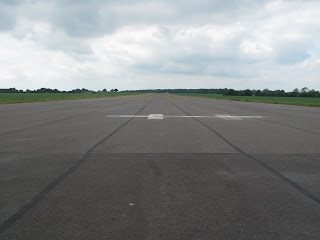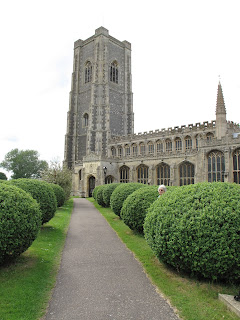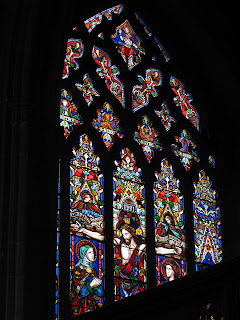We went on to explore the base again and when I climbed the stairs to stand up on the "porch" of the tower, probably where the commanding officers would have stood as they counted the number of planes returning vs. the number of planes that left, I could almost feel the anguish they must have felt as they found out how many of their men were returning ... and how many were not. The place felt almost sacred. No, it did feel sacred. How many planes returned with engines burning, landing gear not down meaning the airman in the ball turret knew he was going to die, men injured and shot up? As we stood there, the sound of a plane in the distance whispered over the field, the same sound that all on this post would wait to hear many hours after the squadron left. It was almost ghostly, spiritual, and yet it was 65 years ago.
This shot is from the tower looking toward the runway which runs near the tree line in the distance.

What looks like an ordinary runway leaves a heritage of extraordinary events.
An avenue of Quonset huts was still there, each hut numbered. We could only peek in one small one whose windows were at eye level and it is now someone's wood working shop. Funny how time moves on, isn't it?
It was time for us to move on, too, and see if we could find the museum in Buxhall. Find it we did with a hand-painted sign on the road "Granary Crafts, Tea Room and Bygones Museum" and when we got there, it was closed! Reciting our story once again to the white haired man trimming the hedges, we found out it was his collection and he would be happy to show it to us but his wife had gone off with the keys and we should return at 2:00.
It was now around 11:30 and having to be back in this area at 2:00 meant we could not move on with our day as planned, so back we went to Rattlesden to its other pub which we had been told served no food and was where the drinkers went! We had now traversed the same roads about 4 times, each time saying "We've been here before!" It got to be a joke for us. Since this was only a drinking pub, lunch for us was two bags of crisps (what we call potato chips; chips here are what we call french fries), a bag of cashews, 1/2 pint of Adnams Spitfire ale and a diet Coke! We have found that our nutritional needs here are often compromised by our adventures.
Unfortunately, we just missed meeting a very elderly man who, as the "drinkers" there told us would probably have enjoyed talking to us all day. We were sorry about that. They soon will be gone and their stories with them.
Returning to the Granary Crafts, our host and his wife (with the keys!) were waiting for us and showed us into the back of the shop where there was room after room of the most amazing collection of bygones, for sure!
We were directed to a small room on the right where his collection of local WWII memorabilia was displayed. And here is where the serendipity occurs - on the bulletin board was a picture of Uncle Robin and his crew of "The Paper Doll". Granted, it's a picture John already has but to think that it would be in the back of a craft shop located on Lower Street, Buxhall. It literally brought me to tears. What respect it shows once again by the English people of the role our country played and the sacrifices these men made. A casual conversation had led us to a touching display of loyalty and recognition of "our boys" and the role they played in this country's war.
Frances Robin Graham, 1st Lt. and pilot, stands on the far left with his crew.
After profusely thanking our hosts for their concern and hospitality, we moved on to Lavenham because we had heard there was a pub called The Swan which might possibly have signatures of American servicemen on its walls. Lavenham is known for its half-timbered buildings, it's Norman church and it's history as a wool town and once one of the richest cities in England. One after another, the streets are lined with homes and shops built in the 15th and 16th century. Whenever I say something like that, it just sort of boggles my mind.
This house has a herringbone pattern in brick in between the studs.
And this is one of the main streets in the town. Amazing, isn't it? The Swan is on the right and includes all the timbered building you see to the curve.
We were so tired when we arrived in Lavenham (remember that late night we had last night?), so we found a parking space, put the seats down and zonked out for about 30 minutes! When we woke up, we realized we were on the corner where The Swan Hotel is located. Since the hotel had the same name as the pub we were looking for I felt it made sense to go inside. There are many pubs named The Swan in England so this could just be another repeat but it's worth a look. When we entered the lobby of this very swank hotel whose buildings are around 500 years old, there was a framed notice on an easel that we were welcome to look around and please visit the Swan Pub where servicemen from WWII had signed the walls! We found it and it was really touching to not only see the signatures but to see how the hotel had taken precautions to protect them by putting a glassed frame over the wall.
Since the pub with the signatures turned out to be about 10 miles from Rattlesden, we realized that it was unlikely to find Robin's amongst them, but John photographed them all to look over closely at a later time.
This is the interior of a meeting room and you can see how they remove the walls but leave the framework so you can see the interior beauty of the structure.
One of the most famous buildings in Lavenham and probably in England is the Guildhall. This was built as a community meeting hall and 500 years later is still being used for the same reason. It is also a wonderful museum of the town and the wool industry that made it rich. This fireplace is so big I can almost stand up in it.
One of the architecturally outstanding buildings in Lavenham is the church, of course, as in many towns. This church particularly reflects the wealth of some of its citizens. It's called a "wool church" because it is the wealth of the wool families that built it. The chancellery dates back to the 14th century but most of it is 15th and 16th century.
Although many of the churches are very similar, I never tire of going in and experiencing the awe I feel as I contemplate how these massive buildings were built, the skills and patience of those artisans whose efforts created these sacred, quiet and soaring spaces for generations who want a place to worship.
After visiting the church, we walked down the street to The Cock - that's a bird, folks - for dinner and returned to the B&B for a quiet time of reading and writing in the lounge. We were so grateful for the precious things and places we had found today.

















No comments:
Post a Comment